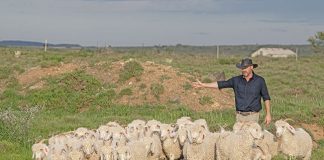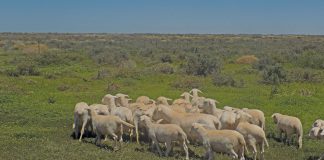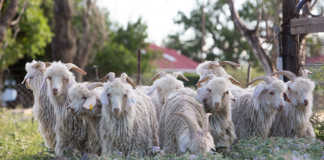Ben Lategan’s 180ha of flood-irrigated lucerne is a green swathe of feed that has remained the productive heart of the Sunnyslopes Merino enterprise, and smaller beef enterprise, for the past half century, thanks to careful management. "I saw the possibilities here with water and the establishment of lands," says Ben (72) pointing across a large expanse of water – one of three irrigation dams he built in the first decade after settling on the farm in 1966. Grazing irrigated lucerne lands enables his Merinos to produce wool and meat under optimal conditions, and Ben is able to harvest lucerne for dry feed when needed.
But it requires careful management, as green lucerne can cause sheep to bloat and die when they graze it. This condition occurs when natural foaming agents in legume plants get trapped in the sheep’s rumen. These tiny bubbles cause the sheep to bloat and compress the lungs to such a degree that breathing becomes impossible and the process of tissue oxygenation and effective blood flow is compromised.
Reducing the risk of using lucerne
"As young man I was moedeloos at the stock I lost on lucerne lands," recalls Ben. "You can never beat bloating,but with the correct management you can win at least 90% of the time."The first step is to ensure sheep aren’t hungry or thirsty before letting them onto the land. Sheep rushing in expecting a feast will almost undoubtedly end up bloated and gasping for breath.Step two is to always handle sheep slowly and calmly to ensure they’re exposed to as little stress as possible.
If sheep are tired, hungry or thirsty, they’ll simply get stuck into the lucerne around them, says Ben. On Sunnyslopes, Merinos are never handled or bothered in the heat of the day – and all lands are fringed with willows Ben planted to offer sheep plenty of shade at all times. Dosing is only done in the cool hours of dusk and dawn. "Minimum handling is important," reiterates Ben. "You never work with sheep in the heat of the day – that gets them bloating quickly."
Step three is making sure sheep always have a source of clean water. Each land on Sunnyslopes has its own trough of water to which Ben adds a handful of Hypo crystals, his preferred anti-bloating remedy, twice a week. Finally, before moving sheep onto young lucerne (especially during exceptionally hot days) they’re dosed with a teaspoon of sulphur and Bloat Guard (50/50 mixture), followed by a dose of water to make sure the sheep gets it down.
For Ben, the benefits of using lucerne far outweighs the risks, not least because of the plant’s dual purpose. It also guarantees enough feed before and during the lambing of 2 200 ewes every September. Lambing percentage on Sunnyslopes has averaged between 134% and 140% in the past two years – incidentally the driest in almost 20 years. Also, there have been significant numbers of twins – 500 sets have already been born this year.
Managing lucerne lands
Irrigating and managing lucerne lands is fairly easy and inexpensive. For example, only small sections are irrigated by water pumped from the Stormbergspruit. Most of the 180ha is flood irrigated via gravity, cutting down considerably on irrigation costs. Because the lands are used predominantly for grazing, older lands are left for up to 10 years before being re-established with lucerne, despite the slow penetration of grass into the crop. When the 20ha of old lucerne lands are ploughed annually and planted to a rotation crop like oats, it’s done cost-effectively by using minimum till techniques, thanks to the careful initial levelling of lands.
"I never rework a section of land. It’s levelled once and that’s it, so I need only work with tined implements, rotavators and planters when establishing new lucerne," says Ben. This new lucerne, especially the best-producing three-year-old batches, are what provide most of the 20 000 bales produced and stored in five sheds. Along with "chocolate maize", this dry feed helps round off lambs and culls for the market, and supports stock through dry and cold spells. Because of such abundant feed, Ben’s Merinos never see a lick on the veld, only salt blocks. "I tried to use licks, but it didn’t work out economically," he says.
Breeding a larger dual-purpose merino
"Merinos demand the most attention of all the breeds, but they pay," explains Ben. "There are few breeds that can beat a Merino."He seeks to breed an open-faced, smooth-bodied Merino with good body conformation that can produce quality meat and significant wool. Currently, Sunnyslopes Merinos produce wool between 18,9³ and 19,2³ for young sheep and just over 20³ for mature sheep. Mature sheep shouldn’t produce less that 6kg of quality B-length wool if shorn at 10 months.
Regarding meat, Merinos are more than competitive. Ben’s most recent batch of hamel lambs – weaned at between 14 and 16 weeks – slaughtered out at an average of 46,1kg from a batch of six- to eight-month-old animals. "This is all because they get food from before birth via the mother, and because of the food I get a little more wool too," says Ben.
To breed a Merino perfectly adapted to Sunnyslopes, Ben started a stud in the late 1970s. Its registration has currently lapsed, but he selected his best ewes to mate with the often expensive stud rams he bought. But in the early 1990s he started using laparoscopic insemination techniques on his 250 selected stud ewes, with semen sourced from breeders with tried-and-tested gold and silver merit Merino rams.
The switch was brought about after buying disappointing untested stud rams that mostly never performed as expected, explains Ben. "Don’t believe a ram will always breed the way he looks. In earlier years I used to buy rams, but realised that although they were beautiful, I wasn’t getting results. Laparoscopic insemination has let my flock improve drastically," he says.
Currently, Ben keeps between 15 and 20 rams bred on the farm for mating with his commercial ewes, while he markets about 30 rams a year to long-term clients."The rams I keep for myself are the top wool length rams and I get the money spent on laparoscopic insemination back with the rams I sell," he explains.Selecting the correct replacement ewes for his flock is as important to Ben as selecting the correct sires. For example, any of his 700 to 800 selected replacement ewes that don’t conceive are immediately culled. "An ewe that didn’t lamb mustn’t be sold as breeding stock, it must be culled," he insists.
Contact Ben Lategan on 051 653 1650.













